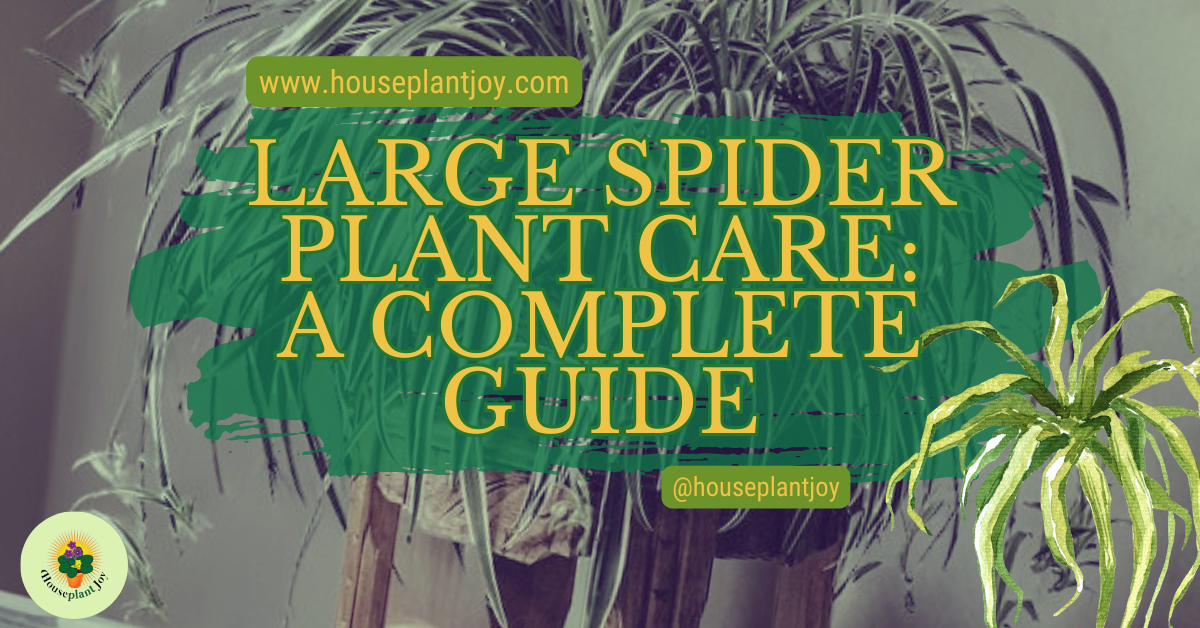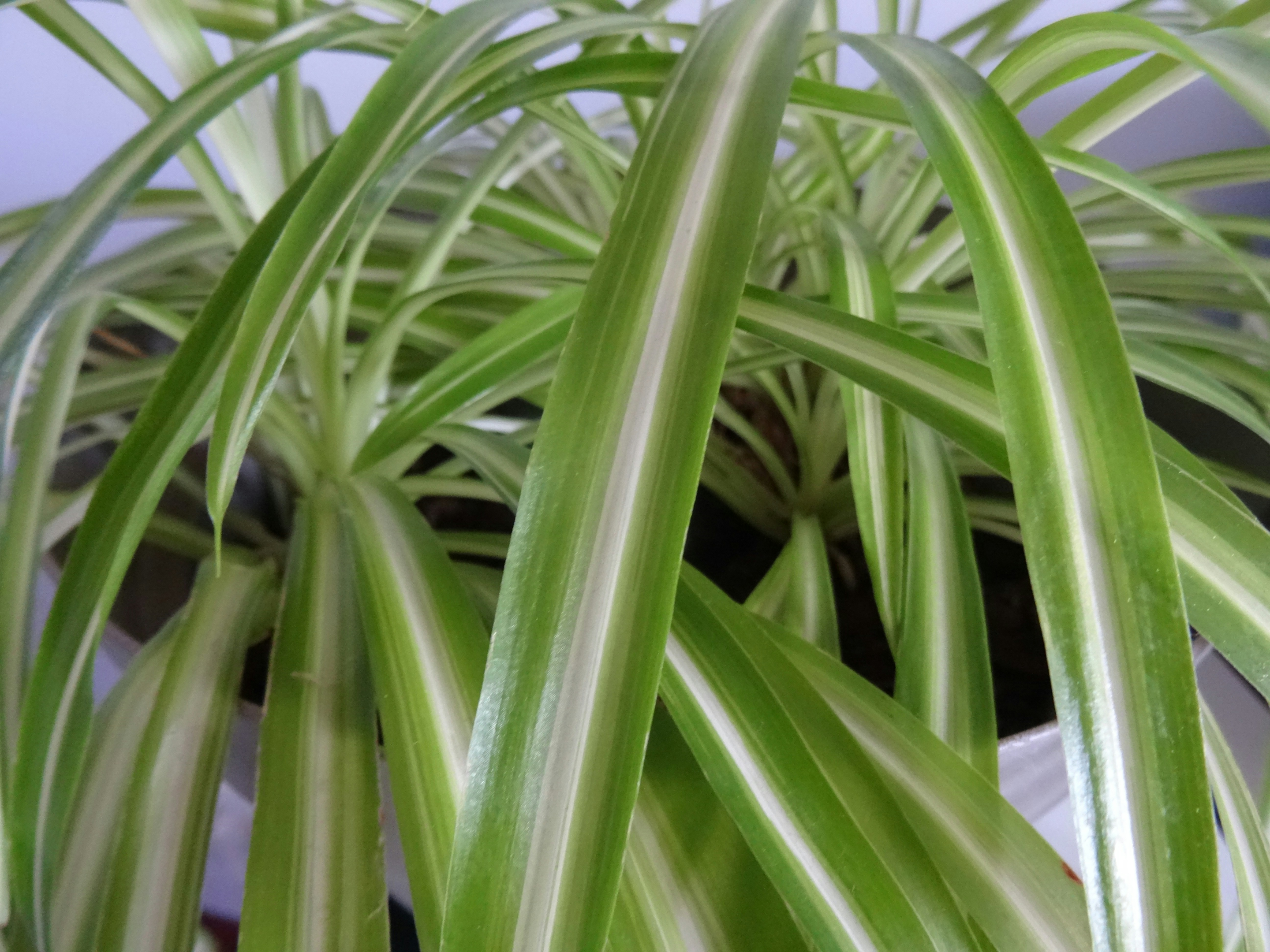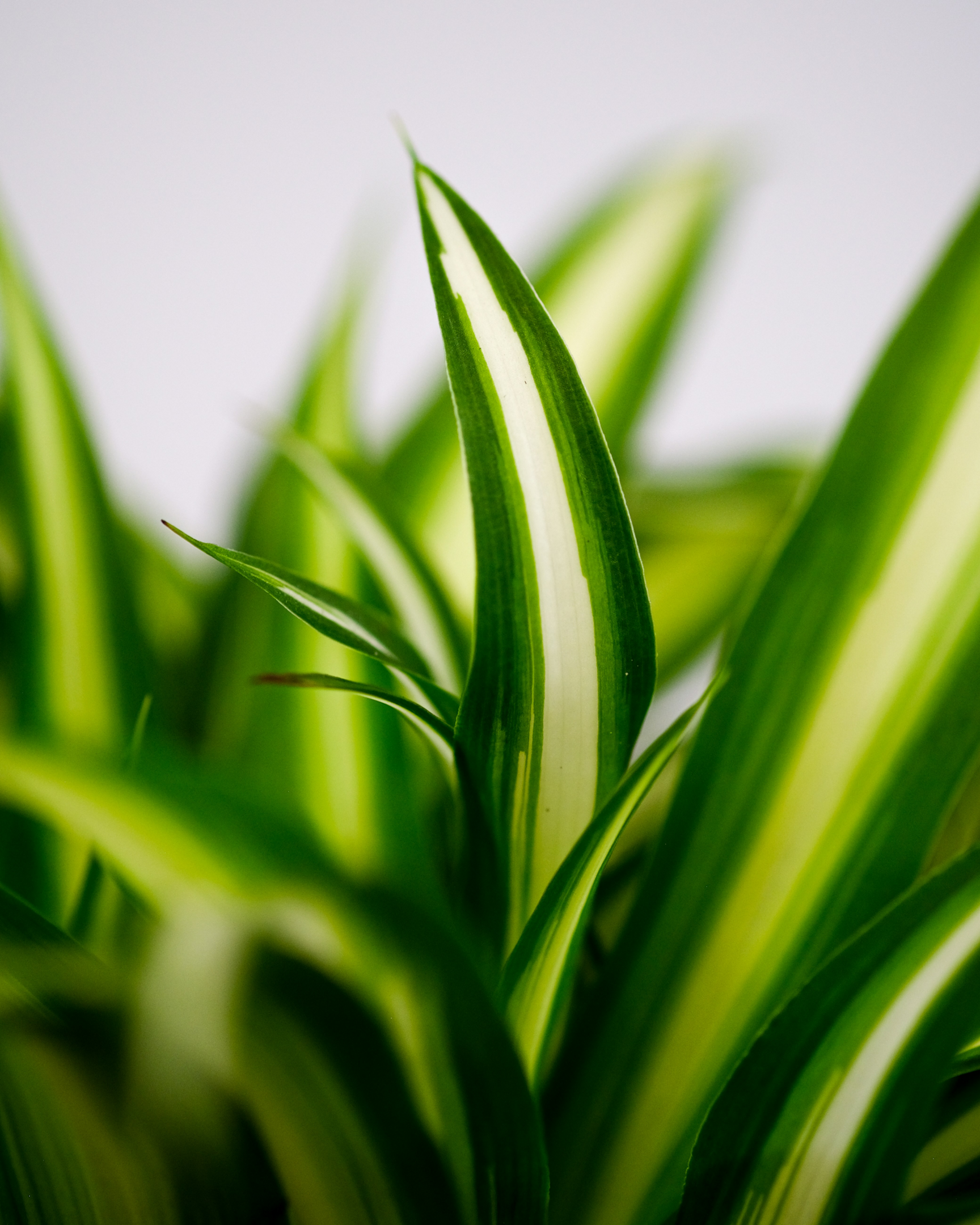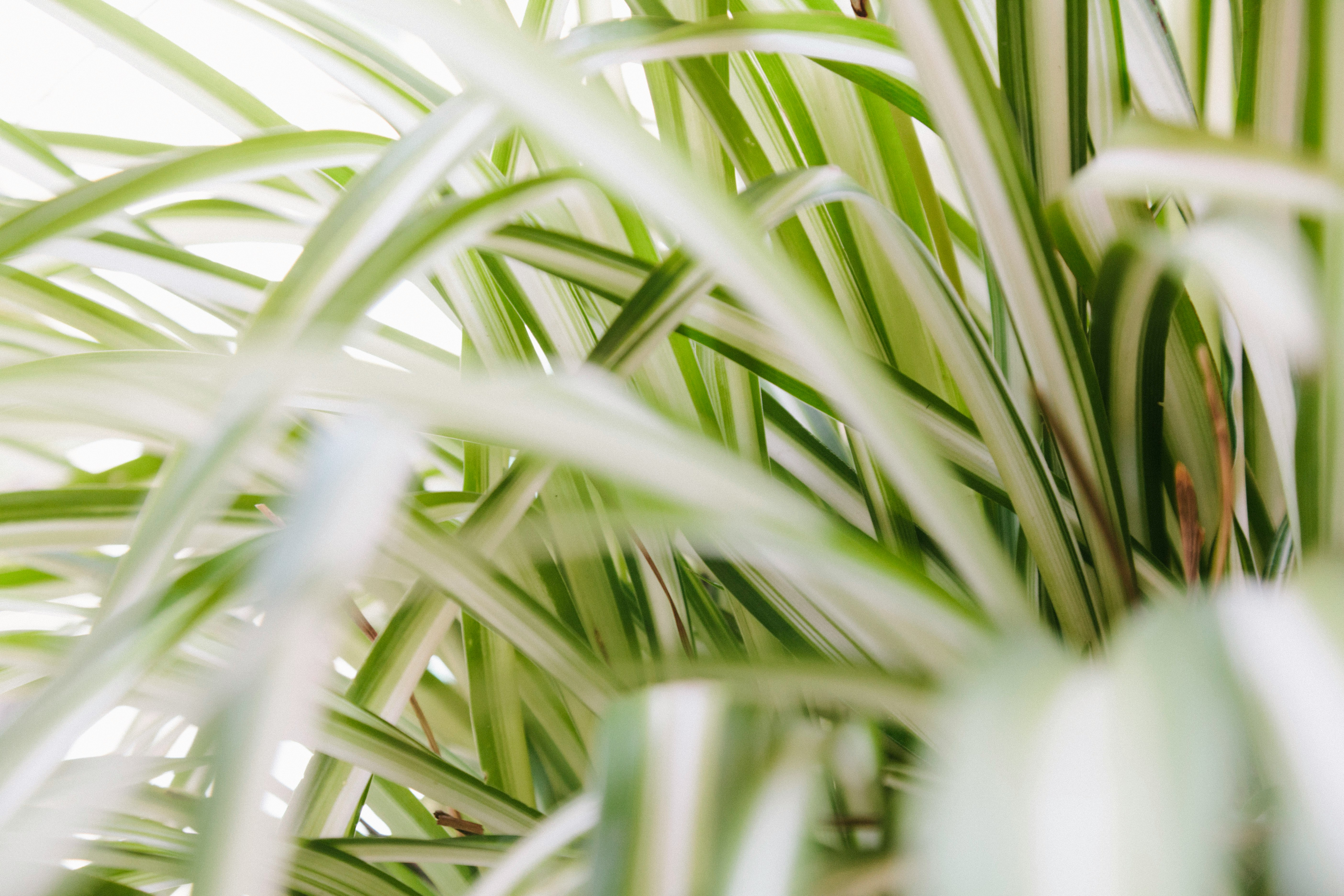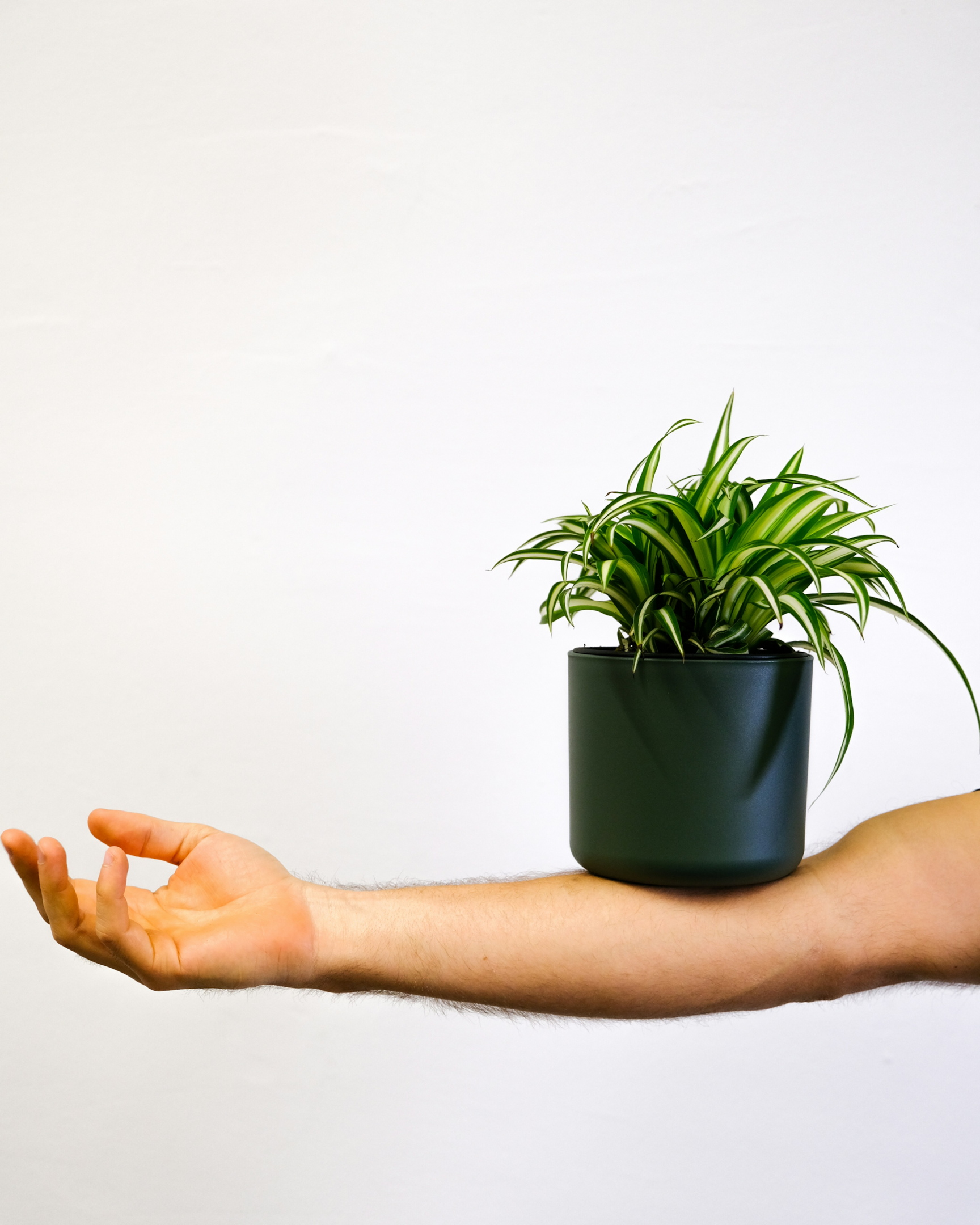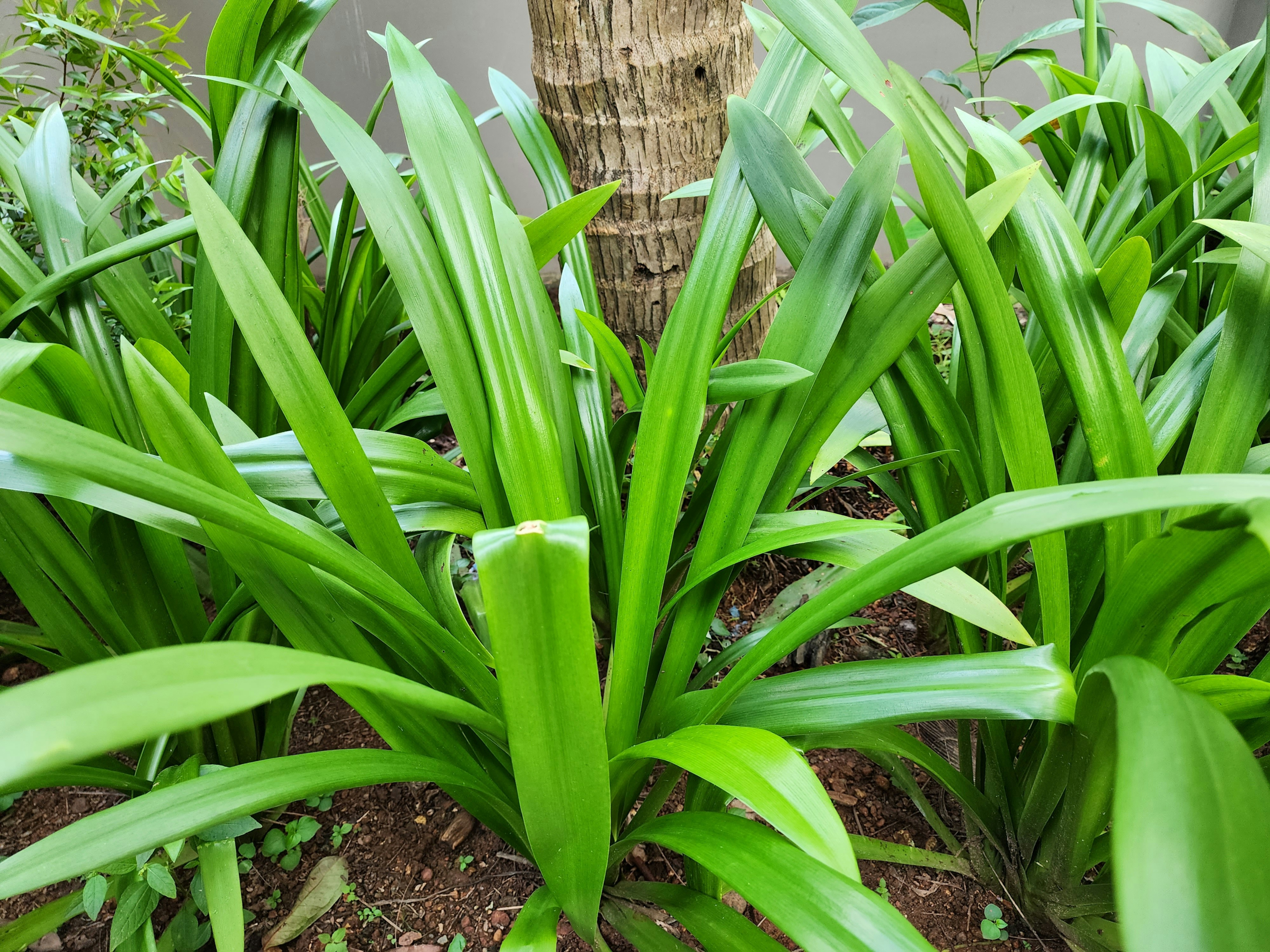HousePlantJoy is supported by our audience. When you purchase through one of our links, we may earn a small affiliate commission. As an Amazon Associate I earn from qualifying purchases. Your cost is not affected.
==================
Welcome to the world of large spider plant care, where we will unravel the secrets of successfully growing and nurturing these beautiful plants. Whether you’re a beginner or a seasoned green thumb, this blog is your go-to guide for everything you need to know about caring for spider plants.
Understanding The Spider Plant
Before we dive into the nitty-gritty of spider plant care, let’s take a moment to understand what spider plants are all about. Also known by their scientific name, chlorophytum comosum, spider plants are popular houseplants characterized by their long, arching leaves and the ability to produce spiderettes, or plantlets that dangle from the mother plant. These spiderettes can be propagated by seed, to create new spider plants, making them a favorite choice for plant enthusiasts.
Photo by feey on Unsplash
The Science Behind the Spider Plant
Spider plants not only add natural beauty to indoor spaces but they also have some remarkable scientific benefits. It has been scientifically proven that these plants greatly improve air quality by effectively removing toxins such chemicals such as carbon monoxide and formaldehyde. But how do they do it? These plants absorb contaminants through their leaves and rhizomes, effectively purifying the air around us. With their attractive green leaves and air-purifying qualities, spider plants have become a favorite choice for beginners and plant enthusiasts alike.
Popular Cultivars of Spider Plant
Spider plants come in a variety of cultivars, each offering its own unique foliage and growth patterns. One popular cultivar is the “Hawaiian” spider plant, which features green leaves with a white stripe down the center, adding a touch of elegance to any space. Another crowd favorite is the flowering “Bonnie” spider plant, known for its large, curly foliage that creates a statement wherever it is placed. If you’re looking for a striking contrast, the “Variegatum” cultivar is the perfect choice, with its green leaves adorned with yellow and white margins.
Lastly, the “Vittatum” cultivar boasts pale green leaves with a white stripe, adding a touch of sophistication to any room. With such a wide range of cultivars to choose from, there’s a spider plant out there to suit every plant lover’s taste.
Essential Care Tips for Large Spider Plants
Video Credits: Epic Gardening
Now that we have a good understanding of spider plants, let’s dive into the essential care tips that will ensure the success of your spider plants. From light requirements to water and soil, taking care of these plants doesn’t have to be complicated. By providing them with the proper conditions, you can enjoy the beauty of these lush, green plants in your home or office.
So, let’s get started with the essential care tips for spider plants.
Photo by Alberto Nicoletta on Unsplash
Light Requirement for Spider Plants
One of the key factors in spider plant care is providing the right amount of light. Spider plants thrive in bright, indirect light, making them perfect for areas with plenty of natural light but not too much direct sunlight.
You can also best place your spider plant near a window with sheer curtains or at a distance from a sunny, south-facing window. It’s important to strike the right balance, as exposing spider plants to too much light can lead to leaf burn, while insufficient light can result in slower growth.
It’s also a good idea to rotate your plant regularly to ensure that all parts of the plant receive adequate light, promoting even growth.
Water and Soil Requirements
When it comes to watering your garden and large spider plants, the key is to maintain a balance of moisture without overwatering. Here are some essential water and soil tips for spider plant care:
- Water your spider plant when the top inch of the soil feels dry to the touch. Adjust the frequency of watering based on the environment, as spider plants may require more water in warmer months.
- Use room temperature water, as spider plants are sensitive to extreme temperatures. If you’re using tap water, it’s best to let it sit for 24 hours to allow any chlorine to dissipate.
- Spider plants prefer well-draining soil to prevent waterlogging, which can lead to root rot. A potting mix specifically designed for houseplants with good drainage is ideal.
- Checking the soil pH of your spider plant is a good practice, as they thrive best in slightly acidic to neutral soil with a pH of 6.0 to 7.0. Adjust the soil acidity if needed using appropriate soil amendments.
Growth Aspects of Spider Plants
As your spider plant grows, you may notice various aspects of its growth that are worth understanding. From the typical growth speed to factors that influence growth, we’ll delve into the fascinating world of spider plant growth and explore whether you have the power to manipulate it.
Typical Growth Speed of Spider Plants
Spider plants are known for their relatively fast growth, especially under favorable conditions and soils. A mature spider plant can grow up to two feet in width, showcasing its lush foliage, while young spider plants may start as small rosettes with a few leaves. The rate of growth of spider plants can vary based on factors such as light, water, temperature, and the overall health of the plant.
Generally, spider plants tend to grow more rapidly during the spring and summer months, when conditions are ideal. As colder months approach, spider plants may slow down their growth, requiring a bit of extra care to ensure their thriving success. So, let’s take a closer look at the factors that influence the growth speed of spider plants.
Factors Influencing Growth Speed
Several factors can influence the growth speed of spider plants, so understanding them can help you create the optimal environment for your plants to flourish. Here are some key factors that can impact the growth speed of spider plants:
- Humidity: Spider plants prefer moderate humidity levels, but they can adapt to a wide range of conditions. Increasing humidity, especially during the dry winter months, can encourage better growth.
- Temperature: Spider plants thrive in temperatures ranging from 60-75°F (15-24°C). Cool temperatures or sudden temperature changes can slow down growth, while higher temperatures can stimulate faster growth.
- Light: Providing bright, indirect light is crucial for healthy growth. Insufficient light can result in slower growth, while too much intense light can cause leaf burn. Finding the right balance is essential.
- Watering: Consistent watering practices, avoiding waterlogging, and maintaining even moisture levels contribute to healthier growth.
- Nutrition: Proper fertilization and the availability of nutrients in the soil are vital for the sustained growth of spider plants. Suitable fertilizers, specifically designed for houseplants, can provide the necessary nutrients.
Can You Manipulate Growth Speed?
While you can’t completely control the growth speed of spider plants, there are certain measures you can take to encourage optimal growth. Bear in mind that spider plants are naturally fast growers, and their growth rate is influenced by various factors. Here are some tips to consider:
- Fertilization: Applying a balanced, water-soluble fertilizer, specifically formulated for houseplants, can provide the nutrients necessary for healthy growth. Follow the instructions on the fertilizer packaging for the correct dosage and frequency.
- Light and temperature: Providing the ideal light conditions and maintaining consistent temperatures within the recommended range can help maintain steady growth. Avoid extreme temperatures and sudden fluctuations, as they can stress the plant and affect its growth rate.
- Pruning: Regularly removing dead or damaged leaves, as well as pruning spiderettes, can redirect the plant’s energy towards new growth, potentially accelerating its growth speed. Pruning also helps maintain the plant’s overall health and shape.
- Proper care: Providing adequate water, light, and appropriate pot size, as well as avoiding common mistakes such as overwatering or using the wrong potting mix, contribute to the overall health of the plant and can indirectly promote healthy growth.
Repotting Your Spider Plant
Repotting is an essential part of spider plant care, as it allows the plant to thrive and grow efficiently. In this section, we’ll explore when repotting becomes necessary and the best practices for repotting your spider plant for maximum growth.
When Is Repotting Necessary?
Knowing when to repot your spider plant is essential to maintain its health and vitality. Below are some signs that indicate repotting may be necessary:
- Root bound: If you notice roots emerging from the bottom of the nursery pot, it’s a clear sign that the plant has outgrown its current container. Repotting will allow the roots to spread and provide room for healthy growth.
- Top-heavy: If your spider plant becomes top-heavy and prone to tipping over, it may be an indication of inadequate pot size. Repotting into a larger, more stable pot will provide much-needed support for the plant.
- Unhealthy appearance: If your spider plant appears unhealthy, with brown tips, stunted growth, or leaves losing their vibrant green color, it may be a sign that toxins have built up in the soil, making repotting necessary.
How to Repot for Maximum Growth
When repotting your spider plant, following the correct steps can help promote maximum growth. Read on to learn some of the best ways to repot your plant. Here are some guidelines for repotting your spider plant:
- Prune unhealthy leaves and spiderettes before repotting.
- Opt for a pot with good drainage to prevent waterlogging,
- Position the plant at the same depth as the previous pot when repotting.
- Use tap water that has been sitting for 24 hours or filtered water to avoid the negative effects of chlorine.
- Place the new spider plant in bright indirect light after repotting.
- By following these steps, you can ensure that your spider plant is well-positioned to thrive and reach its maximum growth potential.
Common Issues with Spider Plant Care
While spider plants are generally easy to care for, certain issues can arise if their needs are not met. In the following sections, we will discuss how to identify problems, pests, and diseases that can affect spider plants, and provide solutions to overcome these issues.
Identifying Problems, Pests, and Diseases
Watch for common problems, pests, and diseases in spider plants. Spotting these early lets you act fast, preventing damage and keeping more leaves of your plant healthy. Look out for brown tips, ensure they get enough light, and be cautious of car exhaust. Bright indirect light is ideal for these house plants. Here are some common problems, pests, and diseases that can affect spider plants:
- Brown tips on leaves: may signal underwatering, over-fertilization, or dry air. Ensure proper humidity, and bright indirect light, and avoid excessive watering. These measures help keep your spider plant healthy and prevent brown tips.
- Presence of pests: Spider plants are generally resistant to pests, but spider mites and mealybugs can occasionally become problematic.
Solutions to Overcome These Issues
If you encounter a common problem with any of the issues mentioned above, here are some solutions to help overcome them. By utilizing these solutions, you can address the common issues that may arise with spider plant care and ensure the continued health and vibrancy of your plant.
Pruning Your Spider Plant
Pruning your spider plant helps maintain its health and appearance. Regular pruning encourages new growth and prevents legginess. Trim yellowing leaves at the base to make room for healthy foliage. Removing brown tips enhances the overall look. Prune back long stems to manage the plant height and create a fuller, bushier appearance. Remember, a well-pruned spider plant is a happy plant!
When Should You Prune Your Spider Plant?
Pruning your spider plant is best done in the spring or early summer for optimal growth. Trim discolored or damaged leaves and spiderettes to keep your plant looking healthy. Regularly removing spiderettes will prevent overcrowding and enhance their aesthetics. After repotting, prune your spider plant to promote new growth, but avoid excessive pruning during its dormant period.
The Right Way to Prune Your Plant
To promote new, healthy growth, trim leaves at the base near the soil to remove any damaged foliage. Snip off spiderettes near the mother plant, leaving a small part of the stalk. Before and after pruning, use rubbing alcohol to disinfect your tools to prevent any potential spread of disease.
Avoid removing more than 20% of the foliage in a single pruning session to maintain the plant’s health. Pruning is a good idea for encouraging new growth and maintaining the overall appearance of your house plants.
Photo by Waseem Ibn Yousef CM on Unsplash
Spider Plant Care Myths and Legends
Despite common misconceptions, spider plants are not toxic to pets. They can thrive without much light, contrary to popular belief. The myth about their ability to purify air from car exhaust is unfounded. Additionally, they can grow outdoors in suitable climates, not restricted to indoor environments.
It’s also a misconception that spider plants always produce spiderettes. These myths and legends often lead to misunderstandings about the care and requirements of spider plants.
Debunking Common Spider Plant Myths
Video Credits: Sheffield Made Plants
Spider plants are safe for homes with pets. They’re fine with not much sunlight and do well in indirect light. You don’t need to put them in a bigger pot often; they like being a bit cramped. Even though they have baby plants, you don’t have to keep moving them. They can stay in the same pot for years. Don’t water them too much; let the soil dry out between waterings to keep them healthy.
What Happens if Your Spider Plant Still Isn’t Thriving?
If your spider plant isn’t thriving, check the lighting conditions to ensure it’s getting bright, indirect light. Also, make sure the temperature and humidity levels are suitable. Adjust the light levels and your watering schedule and consider using a balanced, water-soluble fertilizer to boost growth.
Last Few Reminders on Large Spider Plants
In conclusion, taking care of a large spider plant doesn’t have to be daunting. By understanding the science behind it and following essential care tips, you can ensure its success. Remember to provide adequate light, water, and soil requirements for your spider plant to thrive.
Pay attention to its growth aspects, such as speed and factors influencing it. Repotting when necessary and identifying and solving common issues are important steps in maintaining a healthy spider plant.
Don’t fall for common myths and legends surrounding spider plant care. And if your plant still isn’t thriving, don’t give up! Seek advice from experts or fellow plant enthusiasts to troubleshoot and nurture your spider plant back to health. Happy gardening!
Frequently Asked Questions on Large Spider Plant
What Are the Ideal Conditions for a Spider Plant to Thrive?
To ensure your spider plant thrives, provide bright, indirect sunlight. Use well-draining soil that’s consistently moist but not waterlogged. Maintain temperatures between 60-75°F (15-24°C). While spider plants can tolerate low humidity levels, occasional misting or a humidifier can benefit them.
How Often Should I Water My Large Spider Plant?
To keep your spider plant thriving, water it once a week or when the top inch of soil is dry. Ensure the potting mix is well-draining and allow excess water to drain out. Avoid letting your spider plant sit in standing water to prevent root rot.
Are There Any Common Pests or Diseases That Can Affect a Large Spider Plant, and How Can They Be Prevented or Treated?
Spider plants are generally resistant to pests and diseases. However, they can be affected by common pests like spider mites and mealybugs. To prevent infestations, regularly inspect your plant and keep it clean. If you do notice an infestation, treat it with insecticidal soap or neem oil.
What Are Some Tips for Propagating a Spider Plant?
To propagate a spider plant, take baby plants or spiderettes from the main plant. Carefully remove and plant them in the soil. When dividing, choose a healthy section with at least three leaves and roots. Let the new plant establish roots before watering regularly.
Follow Our Socials
Welcome to the lush world of HousePlantJoy!
Dive into the greenery on our Instagram, where we share captivating photos of vibrant houseplants and tips on how to keep them thriving. Connect with fellow plant enthusiasts on Twitter to discuss all things leafy and discover new varieties to add to your indoor jungle. Looking for inspiration on how to arrange your plants or create your oasis at home?
Explore our Pinterest boards for stunning visuals and creative ideas. Join our Facebook community for a friendly space to exchange advice, troubleshoot plant woes, and showcase your plant havens. Follow us across all platforms for a joyful and green adventure! #HousePlantJoy #PlantParenthood #GreenHomeHappiness
Related Articles on Large Spider Plants

